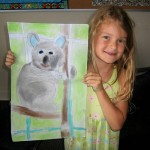Art Instruction: How to Draw
 As an art kid, I spent hours and hours drawing, making and creating. To this day, I love art. Throughout elementary, high school and college, I took as many art classes as possible. Yet, while I was passionate about drawing, there was always a bit of frustration that accompanied the experience. I discovered that instruction in art education is essential to empowering children to communicate visually.
As an art kid, I spent hours and hours drawing, making and creating. To this day, I love art. Throughout elementary, high school and college, I took as many art classes as possible. Yet, while I was passionate about drawing, there was always a bit of frustration that accompanied the experience. I discovered that instruction in art education is essential to empowering children to communicate visually.
For years, I struggled to draw something the way I saw it. I longed for information that offered “how to” instructions. Art classes did not offer this approach. Instead, we art students were encouraged to express ourselves freely and to create from within. I needed direction. I carried some self-doubt, believing I didn’t know everything I should.
For many years, I thought I was the problem and that I wasn’t good enough. I believed I was not as artistic as I could be. Now, as an experienced art educator, I realize the problem was never me. It was the lack of direct instruction. It seems there is a peculiar notion in the visual art that giving kids too much information will stifle their creativity. There is a fear that if we tell too much we will hinder a child’s ability to be spontaneous in their expression. My experience was exactly the opposite as I highlight in my book Being Visual. It was the lack of information that stifled my creativity.
I have dedicated the last 24 years teaching children the ‘how to’ of art. Since developing and teaching Young Rembrandts, I have witnessed children who previously lacked confidence in their ability to create suddenly become empowered and thrive with the right instruction. Week after week, their confidence, their view of self, along with their artistic abilities grew. Information empowers the art kids and the non-art kids. Art training equips children to express their creativity, is a means of communication and is essential to learning visually.
 |
Bette FetterFounder and CEO of Young Rembrandts and Author of Being Visual |










